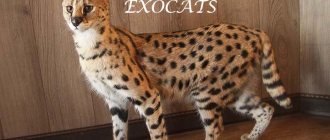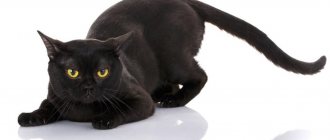The serval is the only cat with wild blood that can be raised to be gentle and affectionate if you take it as a baby from a domestic serval nursery. Both a country house with a fenced area and a spacious apartment will be an excellent haven for the serval.
Representatives of this breed are becoming increasingly popular due to the similarity in character and behavior with dogs. Servals have the grace of a cat and the devotion of a dog, they surprise with their ability to rush after a ball and bring it in their teeth, and to walk on a leash along a country road. That is why the name “catdog” stuck to them.
Read in our article who a serval is, what is remarkable about a serval cat, how to care for animals, what they feed, how much a serval kitten costs.
Origin of the breed
Servals live in the forests of the equatorial zone of Africa, in the Sahara and the extreme south of the continent. In Algeria and Morocco, these cats are rare, but it is quite possible to meet a serval in East and West Africa. The largest population lives in the Ngoro-Ngoro crater (Tanzania), the population density is 40 individuals per 100 sq km. Tall grass and bushes allow the cat to camouflage itself and sneak up on its prey unnoticed.
Servals choose places close to water. Therefore, at home, it is advisable for pets to organize an artificial pond, such as a fountain, and place vases with flowers in an inaccessible place. If it’s raining outside, it’s better to keep the doors closed, otherwise the serval will instantly spread dirt throughout the house.
The breed received its name in honor of the nickname of the spotted cat of Georges-Louis Leclerc, Comte de Buffon, who lived in the Royal Menagerie at Versailles in 1765.
In 1776, the scientist Schreber discovered this living creation of nature to the world. Over the course of 80 years, several other subspecies of serval have been discovered. In 1858, an official classification was presented, in which the animal was classified as a mammal, carnivore, cat family, and serval species.
Interesting. Research has shown that the serval, caracal and African golden cat form one of eight lineages of cats that are at least 8.5 million years old.
Servals make different interesting sounds:
- they scream shrilly, inviting other individuals;
- growl;
- spit;
- purr;
- chirping like birds.
Seeing a serval in its natural habitat is not an easy task. This cat leads a secretive lifestyle. Servals have the longest legs among cats, which allows them to make agile jumps and skillfully dig holes. Animals can jump up to 2.7 m to catch a bird and dig up to 1 m under a fence.
Area
Servals are wild cats of Africa, originally found throughout its territory, now found in the southern part of the continent, especially in Zimbabwe and South Africa. Small populations are found in the Atlas Mountains. They have also been found in Algeria, Morocco, Ethiopia, and sub-Saharan Africa. Thanks to translocation efforts, individuals of this species can now be found in northern Tanzania.
Description and standards of the serval
Serval is a slender, long-legged handsome man. The body length is 65-100 cm, the tail is 25-40 cm, the height at the withers is 55-60 cm, the weight of males is 9-18 kg, females 9-13 kg. As for long legs, this feature is due to elongated metatarsals.
A distinctive feature of the breed is large sickle-shaped ears, decorated with black with yellow or white transverse spots, as well as a miniature head. The wool is decorated with dark spots and stripes on a yellow-gray background. The muzzle, chest and belly are white or light yellow.
The main coat color of the domestic Serval cat is from sand to copper. The spots are black or dark brown. Each individual has a unique pattern. Spots and stripes vary in size and location.
Cats living in African grasslands have larger spots than forest dwellers. The marking extends from the top of the head, down the back and is divided into four lines. In the shoulder area, the lines break and diverge along the stripes. On the tail, the spots transform into rings. The tip of the tail is colored black. The back of the ears is black.
Interesting. Males and females mark their territory with urine: they spray it on plants and rub fresh urine into the soil with their claws. Males spray liquid up to 41 times per km², females do this half as often.
Economic significance for humans
Positive
African servals are traded as exotic pets. The famous Savannah cat breed (with patterns - spots, lines, stripes, dots, and usually along with a mark resembling the letter 'M') is a hybrid of a domestic cat and a serval. The skins of bush cats are considered a valuable product and are used to make capes for tribal leaders. Servals may also contribute to the ecotourism that is developing in Tanzania, where the species is native.
Negative
Bush cats have become accustomed to people and vehicles through tourism, agriculture, and relocation. In rare cases, they prey on dogs and birds.
Features of character and behavior
There is an opinion that servals are dangerous and aggressive cats. This myth is far from reality and is spread by those who have never seen a serval at home. In the wild, these cats hunt small birds and rodents, and perceive humans as an insurmountable rival, therefore, the most they can do is hiss at the sight of a biped. In the event of a direct threat, servals fight and rarely attack, except in situations where the mother cat is forced to protect the kittens.
Domestic servals are afraid of aggressive children - those who pull their tails, pull their ears and paws, grab their fur painfully, squeal loudly, hit them, chase them, or lean on them with all their weight. It is clear that no animal will like this behavior. In such situations, the serval will defend itself using its claws and teeth. That is why experts do not advise families with children under 5-6 years old to have representatives of this breed. Children often do not understand that they are hurting an animal, but older children can already be explained the rules of behavior with a cat. Otherwise, the serval will constantly hide from the kids, fearing for its safety.
Servals get along well with other pets, especially if they grew up and matured together. Adult cats are introduced to small pets gradually and carefully. It is better not to have hamsters, chinchillas, guinea pigs, parrots, small reptiles, etc., as servals perceive them as potential prey. Strong natural instincts make these cats very persistent and resourceful. The serval can open doors and cages if it senses prey. As for keeping servals and dogs together, it all depends on the breed. If your dog is patient, not aggressive, and does not chase cats, there will be no difficulties.
Nutrition
The serval's diet consists of 93.5% small mammals (rats, mice and shrews) and 5% birds, insects, frogs, lizards, and very rarely carrion. The hunting success rate is 48%, which is higher than other members of the cat family. This efficiency rate was observed in reintroduced and wild servals. Hunting in the early morning has a lower success rate than hunting in the evening.
At the beginning of the hunt, the serval carefully scans the area. The ideal place is one that is located along a road or path, where there is good audibility from all sides. Servals stop periodically and remain motionless for about 15 minutes. If potential prey is spotted, they perk up their ears and rotate them to pinpoint the location of the prey. Once the location of the prey has been established, the cat stalks forward. The serval pounces on prey from a distance of 1 to 4 m, and its forelimbs land on top of the prey. If a predator heard prey underground, it will dig into the ground and use its scent to get to it. Bush cats have a harder time catching birds and insects. They can jump higher than 1.5 m above the ground and catch small flamingos, spoonbills, ducks and other waterfowl. These animals pluck their prey before consuming it.
Kittens and sometimes adult servals “play” with food if they do not kill their prey outright. They toss rats, mice and birds into the air before catching them again and biting them. The prey is usually eaten in the place where it was caught or on the side of the trail when the surroundings are calm.
Maintenance and care
Kittens are like puppies: they love to taste everything. If you want to keep your belongings safe, buy a lot of chew toys at the pet store. This must also be done for safety reasons - children often chew on electrical wires. Anything that is not intended for sharp cat teeth should be treated with a special spray.
There are usually no problems with toilet training a Serval at home. Choose wood or silica gel filler from the range available on the market. By the way, servals do not tend to bury their excrement, as domestic cats do.
If a serval goes to the toilet by passing by, or in a prohibited place, do not reprimand him. Instead, explain where to go and treat the corners with an anti-odor product. The spray will be useful to you in any case, because servals tend to mark their territory. You can also spay or neuter your pet to avoid future problems with unpleasant odors in your home.
Regular-sized litter boxes are suitable for kittens; for adult cats, buy a 60x100 cm litter box and do not forget to change the litter in a timely manner.
If you want to quickly make friends with your Serval and gain respect, hand feed him from infancy. Breeders also advise playing with the cat on the floor so that he does not feel depressed. Your eyes should be at the same level as him. This will help the animal get used to you faster and feel comfortable.
Interesting. Servals can be taken for walks on a leash. The cat gets used to the equipment quickly if you start training from infancy. After a walk, the collar must be removed so that the animal does not accidentally suffocate while playing with it.
Serval food
Before you create a food plan for your serval, find out what they eat in the wild. The diet of cats looks something like this: 80% rodents, 13% shrews, 5% birds, 0.9% reptiles, 0.7% insects.
Of course, it is unlikely that domestic servals can be fed this way. The basis of the menu should be raw poultry (thighs, necks, wings, hearts), ground beef or veal, tuna, mackerel, salmon (fresh or canned), as well as a vitamin complex. Adult animals consume 0.50 to 1.4 kg of meat per day. The calcium requirement per day is 54 mg.
Servals can occasionally be given: hard cheese, dried beef, bananas, strawberries, apples, cherries, lettuce, cottage cheese, tomatoes.
Serval feeding by age:
- Kittens up to six months are fed minced meat mixed with powdered dry IAMS, or premium canned food containing at least 75% protein products.
- From six months, kittens are transferred to a combined type of food (dry and wet food).
- Starting at one year old, cats are given chicken legs or necks. Adult servals are capable of handling a whole carcass of raw chicken.
Do not feed your pets cooked meat - it does not contain enough phosphorus. A deficiency of this mineral leads to a lack of calcium, and as a result, brittle bones.
Allow your animal to eat as much as he wants, but do not leave food out for more than 2 hours. A serval can eat a lot one day and very little the next day. A prolonged lack of appetite is a signal to contact a veterinarian.
Give your cats grass once a week to help maintain normal digestive function.
Provide access to clean, cool water. Place several bowls in different places or buy a fountain.
Health and how long they live
In the wild, servals live 10-12 years, in domestic conditions - up to 20 years. Vaccination is carried out according to the calendar, with vaccines without active viruses. It is very important!
Servals do not have any special health problems, but it is important to monitor the pet’s well-being and behavior. Diarrhea (more than 2 times in a row) leads to dehydration, from which the cat can die in just a couple of hours. At the first symptoms of dehydration, you should immediately seek help. The condition can occur when changing food or developing an infectious disease.
Upbringing
Breeders recommend remembering the rules for raising servals:
- Do not play “attack hand” games, because in the future the cat will constantly use your limbs to attack. Better buy a lot of toys.
- Don't yell or hit the animal, even if it behaves inappropriately, such as jumping on the dinner table or examining the contents of a frying pan. At first, keep a water gun or a spray bottle nearby. Say clearly: “No!” and spray the cat with water. Servals are smart animals and learn lessons like these quickly. In the future, the command “No!” will suffice.
- If your pet is playing and can't hear you, leave him alone in the room. He will quickly realize that he did something wrong.
Servals get very used to their caregivers and, at the sight of rare guests, they hide in a secluded place, running away as fast as they can.
It is important that the cat receives attention from all members of the family, which he perceives as his pack. In return you will receive gratitude, love and affection. Servals very cutely rub their heads and ears against their owners, while emitting a “tractor” purr.
Our advice
When the kitten is still small, you need to make sure that he does not jump from high surfaces, since during this period his legs are still very fragile. An animal can be trained to use a leash, but it is advisable to do this from a young age. Toilet training is not particularly difficult; you just need to choose wood filler for it.
It is necessary to vaccinate your pet on time, otherwise the Serval may get sick and die. Like any pet, a serval needs attention, then it will be kind and trusting, otherwise your pet will become timid, which will negatively affect its character.
Based on materials: exoti.ru, vipleo.com, usionline.com, exani.ru, 29palms.ru, tutknow.ru
Breeding
The African serval is a loner, but during the mating period, natural instincts take over. In natural habitats, male territories are adjacent to territories where many females live for optimal reproduction. Mating often occurs in the spring. The female herself looks for the male and cares for him before the estrus, which lasts only 1 day.
Breeding servals in captivity is impossible without some knowledge of this process. In the world of wildlife, the birth of kittens is a real miracle. Babies are born desired by everyone.
The gestation period lasts 10-11 weeks, 2-3 kittens weighing about 250 g appear in the litter. In the first 11 days, the weight of the babies doubles. Permanent canines appear at six months. Sexual maturity occurs at 18-24 months.
Interesting. Servals are not designed to breed in captivity, but if desired, they can produce wonderful offspring. This process becomes a kind of challenge for breeders: will the person cope or not?
During the breeding season, the behavior of animals changes: anxiety and excessive mobility appear. A cat may bite or scratch a person or other animal. Kittens can be born viable, but sometimes require human assistance.
If a cat becomes pregnant by a normal cat, she can kill the hybrid offspring. Therefore, the owner must be on alert. Such kittens weigh 90-110 g. Males remain infertile for three generations. Cats with a high percentage of wild blood may be fertile, but sometimes become parents of small litters. When kept in captivity for several generations, mating efficiency increases.
Security status
Increasing human populations and agricultural developments have impacted the decline of African servals' habitat and their prey. This leads to hunting by domestic animals as it is an easy and highly nutritious food. Although the threat from these cats is minimal, farmers regularly shoot them. Although the cat population is listed as Least Concern by the IUCN, the subspecies Leptailurus serval constantina is listed as endangered by the US Fish and Wildlife Service.
How to choose a kitten
Before you buy a serval kitten, research all reputable catteries in the country or abroad. Ask the breeder to provide comprehensive information: pedigree, vaccination passport, genetic tests, diagnostic results.
Physically and psychologically healthy kittens are active and curious, but can also hiss at strangers. Many nurseries transfer kittens to permanent families from 10-14 weeks. At this age, babies are already accustomed to the tray, have received age-appropriate vaccinations and have been tested for hidden infections.
How much does a serval cost?
The price is determined taking into account the breed standard, temperament, demand and shortage. In addition, an exotic cat requires high maintenance costs. Servals with distinct features are considered more valuable. A registered breeding kitten suitable for breeding cannot cost less than $1,500.
Domestic servals give birth to small litters once a year, which is why there is a long line of people waiting for them. The cost also depends on the country of residence of the breeder. In Russia, the price of a kitten starts at 500 thousand rubles, in the EU and the USA it reaches 1,000,000 rubles.
Important! You need to buy a serval exclusively with a pedigree, so that in the future there will be no problems with either the content or the pedigree.
Pros and cons of the breed
Advantages of the breed:
- natural beauty and grace;
- lack of aggression;
- balanced character;
- devotion;
- love;
- dog habits - ability to fetch slippers, toys, TV remotes;
- excellent health;
- no problems with upbringing;
- friendliness;
- easy care.
Flaws:
- natural stubbornness - it is necessary to indicate the boundaries of what is permitted;
- the desire to jump to heights;
- tendency to damage property;
- need for personal space;
- aggression in response to shouting and physical punishment;
- marks territory;
- high price.
Habitat
Bush cats are most often found in reed beds and grasslands. They also spend time in forests, bamboo thickets, swamps and streams within their range. The average annual temperature within the geographic range of the African servals is 13.7°C, and the average rainfall is 826 mm/year. Individuals of this species in the Ngorongoro Crater in Tanzania live at altitudes of 1400-2200 m, where winters are mild and there are occasional snowfalls.











